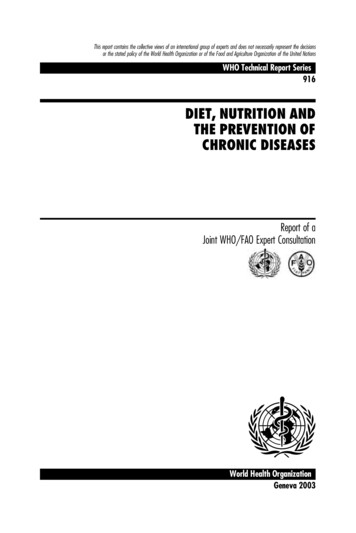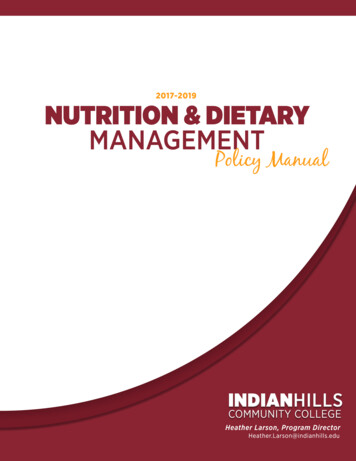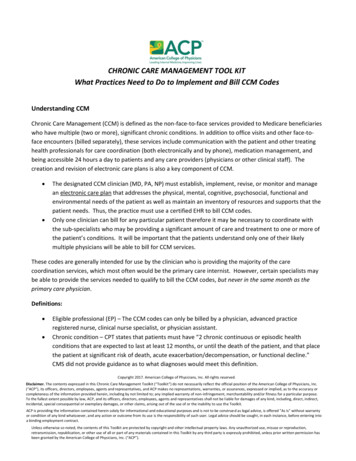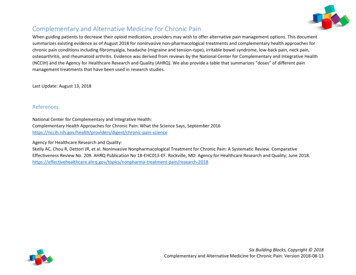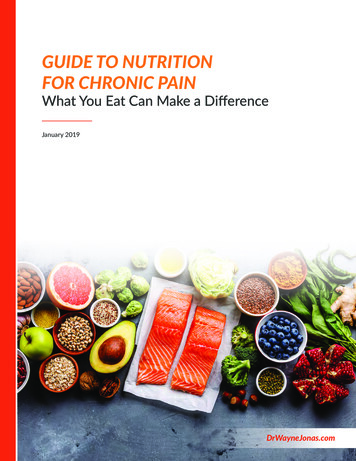
Transcription
GUIDE TO NUTRITIONFOR CHRONIC PAINWhat You Eat Can Make a DifferenceJanuary 2019DrWayneJonas.com
This guide has been developed with the generous support,and on behalf of, the Samueli Foundation.
ABOUT CHRONIC PAINWHAT IS CHRONIC PAIN?Chronic pain is the medical term for pain that lasts more than about three months. Theword “chronic” means “long-lasting.”You feel pain when you break your leg, burn your hand or have surgery. Doctors call this“acute pain” because it happens immediately and goes away with time and treatment. Asyour injury or surgery site heals, you feel less and less pain.Chronic pain is different. You have it even after the injury, surgery site or disease heals.This is sometimes because you have a long-lasting condition in the area that was hurt orhad surgery, such as with arthritis in a shoulder joint that was injured. It can also happenwhen your brain continues to get pain messages from nerves. For example, if you lose anarm or leg, you can feel pain where it used to be. The body part is gone, but the pain stillexists in your brain. To put it another way, if your brain had a “pain” button, it would stillbe on even if no one was still pushing it.You are not aloneResearchers estimate that more than 100 million American adults have chronic pain, soyou are not alone. Chronic pain is one of the leading reasons we visit the doctor and takemedication. It is extremely common.Some chronic pain conditionsConditions that cause chronic (long-lasting) pain include Arthritis—Inflammation in the joints. Osteoarthritis is one type, caused by boneproblems. Gout is another type, caused by a buildup of crystals in the joint. Endometriosis—Very painful menstrual periods are caused by problems with the liningof the uterus (womb). Back pain—Pain in the lower back is common, but pain can happen almost anywherein the back or neck. Migraine—A neurological (nervous system) condition. It includes headaches, visiondisturbances, sensitivity to light and sounds and other symptoms. Fibromyalgia—A condition that causes muscle pain, fatigue (tiredness) and othersymptoms.Guide to Nutrition for Chronic Pain: What You Eat Can Make a Difference2
ABOUT CHRONIC PAINChronic pain affects all of youPain is not just in your body. It can affect your relationships, your work, your sleep andyour mental and emotional health. Pain, especially chronic pain, affects your ability toenjoy life and focus on what you are doing.Back pain is one example of a physical problem that affects other areas of life.Researchers know that if you have lower back pain, you are four times more likely to feelmental and emotional distress than if you were pain free. You would also be three timesmore likely to be limited in what you can do each day.The good news is, making some changes to your daily life can also affect all of you. In thisbooklet, you will learn how something as simple as what you eat can make a difference inyour chronic pain.THE USUAL TREATMENTS FOR PAINIf you have chronic pain, you probably know some or all of the usual treatments. Themain treatments are: Medication—From over-the-counter medications such as aspirin, ibuprofen andacetaminophen (Tylenol ) to prescription pain medications. Non-surgical procedures—Such as injections (shots) and other procedures. Surgery—An operation to fix a problem that may be causing pain. Physical therapy—Exercises, stretching and sometimes massage or ultrasound on thepainful area.These treatments can help acute pain, but they might not be effective for chronic pain.Treatments are not working well if your pain keeps coming back after injections or youconstantly need larger doses of medication.Also, the usual treatments for pain all have some risk. For example, taking a lot ofacetaminophen (Tylenol) or over-the-counter medications called NSAIDs, such asibuprofen (Advil ) and naproxen (Aleve ), can cause health problems. This is mostcommon if you take these medications in large doses, for a long time or both.3Guide to Nutrition for Chronic Pain: What You Eat Can Make a Difference
ABOUT CHRONIC PAINAcetaminophen can cause liver problems, and NSAIDs can cause bleeding in thedigestive system and other problems. So, it is not a good idea to depend on them forlong-term relief.Narcotic medications, also called opioids, can actually make the pain worse. They cancause serious addiction and even death. Taking certain chronic pain medications formonths, years or longer can cause even more health problems besides the pain.The difference between “fixing” pain and healing your bodyWith some injuries and diseases, the pain you feel matches the amount of damage orsickness in your body. With chronic pain, this is not always true. The amount of pain youfeel or how long it lasts might be greater than the damage to your body. In other words,your pain might be more severe or longer lasting than the injury or illness itself.Your doctor might be able to “fix” the injury or illness, but not the pain. If so, the purposeof treatment might change from fixing a problem to healing your body.Healing and curingHealing can happen even if doctors cannot cure, or “fix,” your condition. Healingis the process of becoming as healthy and well as possible physically, mentally,emotionally and spiritually. You might think of this as being a “whole” person,feeling as well as you can in each of these different ways.Some ways to do this are managing your weight, building strength andcardiovascular fitness, staying relaxed and eating well. You can also take care ofyour emotional and spiritual needs to become as happy and balanced as possible.Healing means: Becoming as healthy as possibleBeing able to function as well as possibleAvoiding the problems medications and procedures can causeFeeling as well, happy and satisfied with life as possibleGuide to Nutrition for Chronic Pain: What You Eat Can Make a Difference4
ABOUT CHRONIC PAINTHINKING ABOUT YOUR CHRONIC PAINThe next section of this booklet has some questions about your pain. Writing down theanswers and sharing them with your doctor or other health provider can help you plan toreduce the pain and feel better in general.NOTES5Guide to Nutrition for Chronic Pain: What You Eat Can Make a Difference
QUESTIONS TO CONSIDERABOUT YOUWhat do you live for? What are the most important things in your life?What would you do if you had no pain?ABOUT THE PAINWhere is the pain?How long have you had it?FRONTBACKGuide to Nutrition for Chronic Pain: What You Eat Can Make a Difference6
QUESTIONS TO CONSIDERWhat medicines have you taken for it?Are you still taking any of these medicines?Surgery? Yes NoWhat kind of surgery?Other treatments, such as injections (shots), physical therapy, massage or other?What would be the best possible result of treatment?What result would I be OK with, even if it was not the best possible?7Guide to Nutrition for Chronic Pain: What You Eat Can Make a Difference
QUESTIONS TO CONSIDERIs there anything I am doing now that makes it feel better?Is there anything I think would fix my pain?ABOUT YOUR GOALSWhat goals do you have for your life?Why would you like to do these things?What are the reasons you have not done these things so far?Guide to Nutrition for Chronic Pain: What You Eat Can Make a Difference8
ABOUT NUTRITION, FOOD AND PAINResearch shows 2 things are closely related to both chronic pain and nutrition. Theseare a condition called obesity, which means being overweight, and the type of foodsyou eat. Some foods cause inflammation in the body, which can lead to long-lasting, orchronic, pain. Other foods fight inflammation, which helps reduce pain.The information below explains the connection between obesity, chronic pain and whatyou eat.CHRONIC PAIN AND OBESITYWhat is obesity?Doctors use a measurement called body mass index to learn if you have obesity. Bodymass index, or BMI, shows how much you weigh compared to your height. In most cases,you have obesity if your BMI is 30 or higher on this scale. The obesity is severe if yourBMI is 40 or higher.If you have obesity, you probably know it and are not happy to read about it in a guideabout pain. You might feel blamed for having obesity, like you caused your pain. In fact, itis not you but the extra tissue on your body that is part of your pain. This booklet is partlyabout obesity because it is such a common condition, like chronic pain. Researchers nowknow that obesity and chronic pain often go together.Studies show people who have obesity are more likely to have pain that keeps comingback. They also show that people with more severe obesity tend to have worse pain. Painand obesity go together in every age group along the life span, from children to olderadults. Having a higher body mass index, or BMI, is also shown to lead to low back pain.Why do obesity and pain go together?Researchers believe that one way obesity can cause pain is that the extra mass, oramount, of tissue on your body puts a heavier load on your bones and joints. Just like anoverloaded piece of equipment, your joints can start breaking down faster than normal.They might change shape or rub on each other in ways that cause pain. You might alsostand, sit or walk differently.9Guide to Nutrition for Chronic Pain: What You Eat Can Make a Difference
ABOUT NUTRITION, FOOD AND PAINAnother way is inflammation. Your body’s cells can become inflamed, or irritated, by manythings. Normally, your body calms the inflammation by releasing specific substances.If you have obesity, your body has many fat cells. These cells are active, releasingsubstances that cause a constant, low level of inflammation in your body. Thiscontributes to chronic pain and many other diseases.The connection between food, obesity and painEven separate from weight, what you eat can lower the inflammatory substances in yourbody or raise them. It can also help determine how much fat your body carries. So, whatyou eat and drink can reduce both the fat and fat cells and the inflammation from them.This means it can reduce the amount of pain you have. As a side benefit, eating foodsthat stop inflammation can also reduce obesity, so your body becomes healthier overtime.My Body Mass IndexLearning your BMI can help you determine if you are at a healthy weight. The easiestway is to find a BMI calculator online. You will need to know your height and weight. TheCenter for Disease Control also called the CDC or the National Institutes of Health orNIH both provide good calculators you can easily use online.Guide to Nutrition for Chronic Pain: What You Eat Can Make a Difference10
OBESITY AND CHRONIC PAINHaving Obesity Does Not Make You a Bad PersonFirst of all, having obesity and chronic pain does not mean you are a bad person,any more than having diabetes or depression does. In the United States, we give alot of attention to people who meet very specific standards of beauty. This usuallyincludes being thin or skinny (underweight). Because these people get so muchattention, we tend to think of them as successful, beautiful or somehow betterthan the rest of us. But how they look or how much they weigh has nothing to dowith their inner personal qualities or value. And it is important to know that beingunderweight also causes health problems.However, in the United States, obesity is a much more common health problemthan being underweight. Today, 1 of every 4 American adults has obesity. If youhave this condition, being “body positive” and loving your body is a good thing.However, this probably means taking steps to treat your obesity because of theserious health problems it causes.This is especially true if you have chronic pain. Obesity and chronic pain can bothmake the other condition worse. For example, the more pain you have, the less youare likely to exercise or even move around very much. This may lead to weight gain.Carrying extra weight worsens the pain, and you become even less active. You arealso likely to get depressed from the pain and lack of activity or ability to do things.You might eat more, have less energy to shop and cook for yourself or eat fast foodor junk food for comfort if you are depressed. This also makes the obesity and painworse. All these things add up to make your health even worse.If you have chronic pain, treating obesity can lead to much less pain—withoutdrugs, surgery or other procedures that can have side effects or do more damage.For example, if you start taking a short walk each day, your energy level will goup. With more energy, you can shop for fresh foods and prepare a healthy meal.Exercising and eating fresh foods, with family or friends if possible, makes you feelless depressed—and you might start losing weight. This can decrease your chronicpain. You will also lower your risk of diabetes, heart attack, stroke, cancer andmany other serious health conditions. All these things work together to make youhealthier and help you feel better and better.11Guide to Nutrition for Chronic Pain: What You Eat Can Make a Difference
EATING TO REDUCE CHRONIC PAINResearch shows that foods and drinks that reduce inflammation can reduce chronicpain and improve your mood. Avoiding foods and drink that cause inflammation canalso help. In fact, changing your diet and lifestyle can allow you to work with your healthcare team to reduce the amount of medication you take or even stop taking it. Even smallchanges, such as switching to whole grains and eating more fish and less red meat, canmake a difference in your health.The rest of this booklet gives you suggestions for simple nutrition changes that can helpyou start feeling better.Types of foods thatreduce inflammationWhole grainsFor example, try Whole grain bread, oats, brown rice, barley, bulgur, quinoa,couscous, polenta and rye bread. You can also switch towhole wheat tortillas and pasta.You can use potatoes, sweet potatoes and plantains inrecipes the same way as whole grains. Avoid having thesefried very often because fried foods can cause inflammation.Beans, nuts, seedsand plant foodsthat have a pod,such as peasBlack beans, kidney beans, garbanzos (also called chickpeas),white beans (also called navy beans or cannellini beans),hummus, nuts and seeds. Nuts can include walnuts, almonds,pecans and peanuts. Seeds include sunflower seeds, pumpkinseeds, pine nuts and more.Peas and soybeans are a type of plant called a “legume” thatcomes in a pod. You can eat sugar snap peas, regular peas,roasted soy nuts, edamame and any type of tofu.FruitsBerries, pomegranates and cherries. Dark-colored fruits areespecially good for preventing inflammation.Any other type of fruit. Avoid drinking fruit juice or drink asmall glass and mix it with an equal amount of water.(Fruit juice contains a lot of sugar, which makesinflammation worse.)Guide to Nutrition for Chronic Pain: What You Eat Can Make a Difference12
EATING TO REDUCE CHRONIC PAINTypes of foods thatreduce inflammationFor example, try VegetablesYellow, orange and red peppers and tomatoes. Spinach,chard, kale, leaf lettuce, Romaine lettuce, arugula (rocket orroquette) and mixed greens, especially dark, leafy greens.Purple and green cabbage, onions, garlic, broccoli, Brusselssprouts and cauliflower.Radishes, cucumbers, green beans and green onions(scallions).Olive oilUse this instead of butter and other oils for cooking foods,when possible. You can use flavored or extra virgin olive oilin dips and dressings.FishChoose fish that lived in cold water, including salmon,herring, anchovies, sardines and mackerel. Wild salmon ishealthy to eat, but farmed salmon is not because it usuallyhas a lot of antibiotics in it. Look for recipes using freshsardines, herring and mackerel, or buy them canned from thesupermarket.Chicken, turkeyand other birdsEat white meat chicken and turkey. Avoid frying or deepfrying except as a special treat. Game birds such as pheasantand quail, and farmed birds such as Cornish hens, are fineto eat.Eggs, cheeseand yogurtLow-fat or skim milk, yogurt, natural cheese (not processedcheese such as cheese slices or spreads).Some people do not digest cow’s milk. You can buy milk thatdoes not include lactose (milk sugar) or avoid milk. Checklabels on yogurt to avoid brands with a lot of added sugar.Herbs and spices13Cinnamon, ginger, turmeric, garlic, rosemary, cayenne pepper,black pepper.Guide to Nutrition for Chronic Pain: What You Eat Can Make a Difference
EATING TO REDUCE CHRONIC PAINTypes of foods thatreduce inflammationFor example, try TeaBlack tea, green tea, white tea, herbal tea.ChocolateChoose dark chocolate with 70% cocoa or higher. Eat 1 or 2ounces per day.WineIf you drink, you may have ½ to one (1) drink each day ifyou are a woman, and 1 to 2 if you are a man. Wine canhelp reduce inflammation, but limit the amount you drinkto avoid causing other health problems. Some doctors andresearchers believe it is better to avoid drinking any alcoholat all.Avoid or eat less of these foods Red meat, such as beef—If you do eat beef, have it only on special occasions. Grassfed beef is the best, but it costs more than regular beef, so you might want to plan forit in your grocery budget. Eat less of other beef, including hamburgers, steaks, ribs andbeef in tacos, stir-fry and sandwiches. Processed meat, such as ham, bacon, sausage and lunch meat Certain oils and fats, including margarine, shortening, lard and oils from soybean,safflower, corn and sunflowers White bread Rice and corn cereals and instant oatmeal Instant or white rice, packaged stuffing Foods with high-fructose corn syrup Soda, including diet soda, fruit juice and other drinks with added sugar, such as energydrinks and coffee or tea drinks with flavoringsAlso avoid or eat fewer sweets, especially processed sweets. These include cookies,cakes, pastries such as muffins, donuts, brownies, pies and other sugary desserts.Guide to Nutrition for Chronic Pain: What You Eat Can Make a Difference14
EATING TO REDUCE CHRONIC PAINSimple Food Tips for Less Pain The best diet to lower inflammation and pain is based on healthy foods that comefrom plants. This means getting most of your food from eating whole grains, fruits,vegetables, beans, nuts and seeds. Avoid foods that make your blood sugar go up quickly after a meal, includingwhite bread, refined (processed) grains and other processed foods and sugaryfoods. If your blood sugar does this often, it creates inflammation in your body. Limit the amount of added sugar in your food each day. Daily limits for adults are:»» Men: 39 grams»» Women: 25 gramsThe limits don’t mean you have to eat that much added sugar. You can eat less!But try to stick to that amount or less each day. You will need to read labels tocheck for how much sugar is in a serving of food. Most added sugar is alreadyin the food, even foods you would not expect to have sugar. You might alsoneed to measure the food to learn how many servings you have. Eat plenty of these foods. These can replace other foods you eat now, such aswhite bread, red meat and packaged snacks.»» Fruits and vegetables—Most Americans eat just 1 fruit and 1 vegetable eachday. Often, that vegetable is French fries—high in calories, salt and fat and lowin nutrition. Doctors and nutrition experts recommend eating 5 to 7 servingsof fruits and vegetables every day.»» Herbs and spices—Use these to replace some of the salt you cook with.»» Healthy fats, such as olive oil, flax oil or canola oil.»» Foods made from soy, such as tofu, roasted soy nuts, edamame and soy milk,unless your doctor tells you to avoid soy.»» Fish—Two or 3 times a week. Look at the chart in this guide to learn moreabout the best types of fish.For a basic anti-inflammatory diet, you can use the U.S. Department of Agriculture’sMyPlate example.For a more detailed anti-inflammatory diet, you can use the traditional Mediterraneandiet food pyramid from www.oldwayspt.org. Or search for “Mediterranean dietpyramid” online.15Guide to Nutrition for Chronic Pain: What You Eat Can Make a Difference
SUPPLEMENTS FOR CHRONIC PAINSupplements can be vitamins, minerals, oils or herbs you take to get a specific benefit.For example, you might take a daily dose of fish oil or a multivitamin each day. Thoseare both supplements.If you have chronic pain, you have likely spent time online learning about your conditionand what might help. Chances are good you have found some advertisements forsupplements that promise to take your pain away.It is important to remember that every supplement costs money, but not all supplementswork. Also, the United States does not have rules about how supplements can bemade or what they must contain. So, you might not be buying what you think you are.Visit Operation Supplement Safety at www.opss.org, and choose “Dietary SupplementIngredients” to learn about ingredients and more.Supplements can be expensive, and they can also cause bad reactions with othermedicines you take, certain foods or certain drinks. Before you buy any supplements,please talk to your doctor. He or she should be able to tell you if researchers have foundany evidence that the supplement works for your condition. You can also talk with yourdoctor about why you want to take a supplement—for example, because your painmedicine is not working well any longer or you need more sleep. The doctor may be ableto find something that is proven to work and does not cause harm.Following is a chart showing common supplements for muscle pain. It includesinformation on supplements that researchers have found can help, and those that do nothelp (no matter what you read about them online).Guide to Nutrition for Chronic Pain: What You Eat Can Make a Difference16
SUPPLEMENTS FOR CHRONIC PAINSupplements that may help muscle pain—and some to avoidMay helpNot recommendedAvoidAvocado-soybean oil (alsocalled se hipCreatineCurcuma (in foods, not asupplement)S-adenosyl-t-methionineDevil’s clawGinger (in foods, not thaneMelatoninPycnogenolPolyunsaturated fatty acidsVitamin EVitamin DWillow bark extractFoods and diet can also affect other health conditions. These conditions might be part ofthe cause of your pain, or they might affect the pain in some way.The next chart shows some of these health conditions. It also shows supplements thatresearchers have found to have some benefit for the condition, lists those conditions andthe diet or supplements that have evidence for benefit. Notice how often you see theMediterranean diet or a type of Mediterranean diet on the chart.17Guide to Nutrition for Chronic Pain: What You Eat Can Make a Difference
SUPPLEMENTS FOR CHRONIC PAINConditions that may improve with diet, supplements or bothCondition or diseaseDiet or supplementAlzheimer disease and dementia Mediterranean diet Omega-3 fatty acids Alpha lipoic acidArtery (large blood vessel) problems Mediterranean diet Dark chocolate DASH dietArthritis Turmeric extract Probiotics Omega-3 fatty acidsAsthma Mediterranean dietCancer Mediterranean diet—may helpprevent colorectal, breast andprostate cancerCOPD (Chronic obstructive pulmonarydisease) Fruits and vegetables rich inantioxidantsDepression Omega-3 fatty acids Mediterranean dietDiabetes Mediterranean diet—may helpprevent or control diabetesHeart disease Mediterranean diet, including olive oiland nuts May help prevent heart attackand strokeGuide to Nutrition for Chronic Pain: What You Eat Can Make a Difference18
SUPPLEMENTS FOR CHRONIC PAINCondition or diseaseDiet or supplementHigh blood pressure DASH diet Mediterranean diet New Nordic diet—similar toMediterranean diet Olive oil—especially extra virginolive oilInflammatory bowel disease Turmeric Anti-inflammatory diet—adjusted forirritable bowel diseaseNonalcoholic fatty liver disease Olive oil or canola oil Omega-3 fatty acidsObesity Mediterranean diet DASH dietPsoriasis Diet rich in omega-3 fatty acidsOther herbs and supplements researchers are studying for pain: TurmericGingerGarlicWhite willow BoswelliaDevil’s clawMSMSAMe19Guide to Nutrition for Chronic Pain: What You Eat Can Make a Difference Protease Bromelain Resveratrol
EXERCISE FOR CHRONIC PAINWHAT ELSE CAN HELP?Getting physical activity every day can help reduce inflammation and pain. Exercisegets your blood flowing and helps fluids cushion your joints. It helps your bodyproduce chemicals that raise your mood, and it also helps you sleep better. If you havesevere pain, you need to start exercising little by little. Otherwise, the exercise may makeyour pain worse.No doubt about it that exercising with pain is, well, painful. But it needs to be doneanyway. If you exercise regularly, a little more each time or each week, you will feel bettereventually. You will feel pain and discomfort, but exercising this way helps you avoidmaking your pain too much worse. Work with a professional when you start exercising,like a physical therapist or a certified yoga therapist.Exercise doesn’t have to be hard or expensive. Just taking a walk every day can make abig difference. Try to get 150 minutes a week of moderate exercise. This is 25 minutes,6 days a week, so you can even take a day off. Or you can do 25 minutes a day byexercising 5 or 10 minutes at a time, several times daily.What is “Moderate” Exercise?“Moderate” exercise means you are making some effort, but you can still talk to afriend. You are not sweating heavily. It could be: Walking Hiking Swimming Riding your bike Riding an exercise bike Doing yoga or tai chi Doing an exercisevideo or classDoing an activity that strengthens your muscles on at least 2 days a week isrecommended. This could be lifting weights, push-ups or sit-ups. Make sure you do theexercises the correct way. Otherwise, you could hurt yourself more.Changing how you shop for food and cook, serve and eat it can be important, too. Thenext section gives some ideas about food that can make the whole eating process anutritious, healing experience.Guide to Nutrition for Chronic Pain: What You Eat Can Make a Difference20
NEW WAYS TO THINK ABOUT FOOD AND NUTRITIONWATER IS LIFEYou’ve probably heard it too many times to count: your body needs water. You are60 percent to 70 percent water, and you lose it all day and all night through sweat,evaporation, waste and other ways. Replacing the water your body uses—and loses—isessential when you are trying to feel as well as possible.Ways to get enough water: Carry a reusable water bottle and keep refilling it during the day. If you don’t like thetaste of tap water where you live or work, look for a bottle with a filter. Filters canmake plain tap water taste delicious! Have a glass of water with each snack and meal. If you have another beverage, have aglass of water, too. Replace 1 or 2 of your other daily beverages with water. Eat foods that contain a lot of water, including melons, tomatoes, cucumbers andother fruits and vegetables.FOOD IS MORE THAN FUELTry thinking about food as something that gives you energy and health. We tend to thinkof medicines and supplements this way, but not our food.Food that gives energy and health includes: Foods with healthy fatProteinFiberWhole grains and other healthy carbohydrates“5 a day”—Five servings of fruits and vegetables dailyEating plenty of fiber, such as from fruits, vegetables and whole-grain food, can reducethe harm from foods that have a lot of sugar, corn syrup, chemical sweeteners andunhealthy fats. Eating less of these sugary foods will also improve your energy andhealth.21Guide to Nutrition for Chronic Pain: What You Eat Can Make a Difference
NEW WAYS TO THINK ABOUT FOOD AND NUTRITIONAre you eating enough?Enough food is important. If you are always tired, you might be eating too little duringthe day or all the time. Or you might be eating too little high-quality food, such as healthyfat, protein, fiber and fresh fruits and vegetables. If you eat fast food, drink soda (regularor diet) or eat mostly packaged food every day, you might be tired because the chemicalsand sugar are causing inflammation.Ask your doctor for helpCreating a healthy eating plan can be confusing and take a lot of time. Ask your doctorif you can talk with a dietitian about what to eat and drink. A dietitian is a health careprofessional who studies food and nutrition and helps people decide what to eat to getthe results they want.Most doctors will not give you advice or counseling on nutrition unless you ask them.However, some current guidelines for medical practice recommend that doctors do giveyou nutrition advice. The guidelines especially recommend it if you have a disease suchas diabetes, hypertension, obesity, heart disease or cancer. They might also recommendyour doctor give you nutrition advice if you have a high risk of getting any of thesediseases.Medical guidelines are also recommending that doctors talk to you about nutrition if youhave pain or a brain illness such as depression or dementia. But you probably need tospecifically ask your doctor to talk with you about nutrition.You can also ask that your doctor do something called a HOPE visit with you. You or yourdoctor can learn how to do this online at www.drwaynejonas.com/hope.Guide to Nutrition for Chronic Pain: What You Eat Can Make a Difference22
NEW WAYS TO THINK ABOUT FOOD AND NUTRITIONEATING WELL—IT’S NOT JUST ABOUT FOODThe Mediterranean diet includes many foods that can help your health. However, peoplewho eat this diet in Greece, Spain and other areas where it comes from might be healthyfor another reason. They tend to eat with others, pay attention to the food and take timeto enjoy it. These things are as healing as eating healthy foods. The social part of eating,and how you think about eating and food, can be as important as the food itself!Here are some ideas for planning meals and eating foods that build yo
Back pain—Pain in the lower back is common, but pain can happen almost anywhere in the back or neck. Migraine—A neurological (nervous system) condition. It includes headaches, vision disturbances, sensitivity to light and sounds and other symptoms. Fibromyalgia—A condition that causes mu

